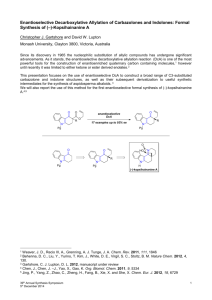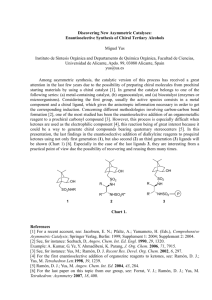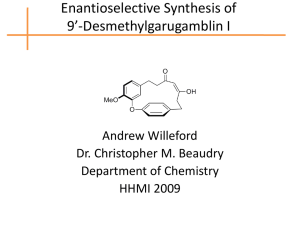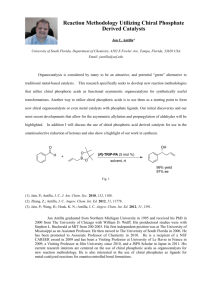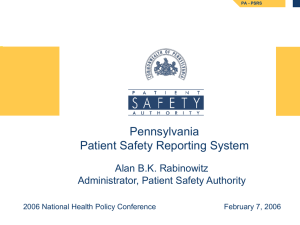View Essay
advertisement
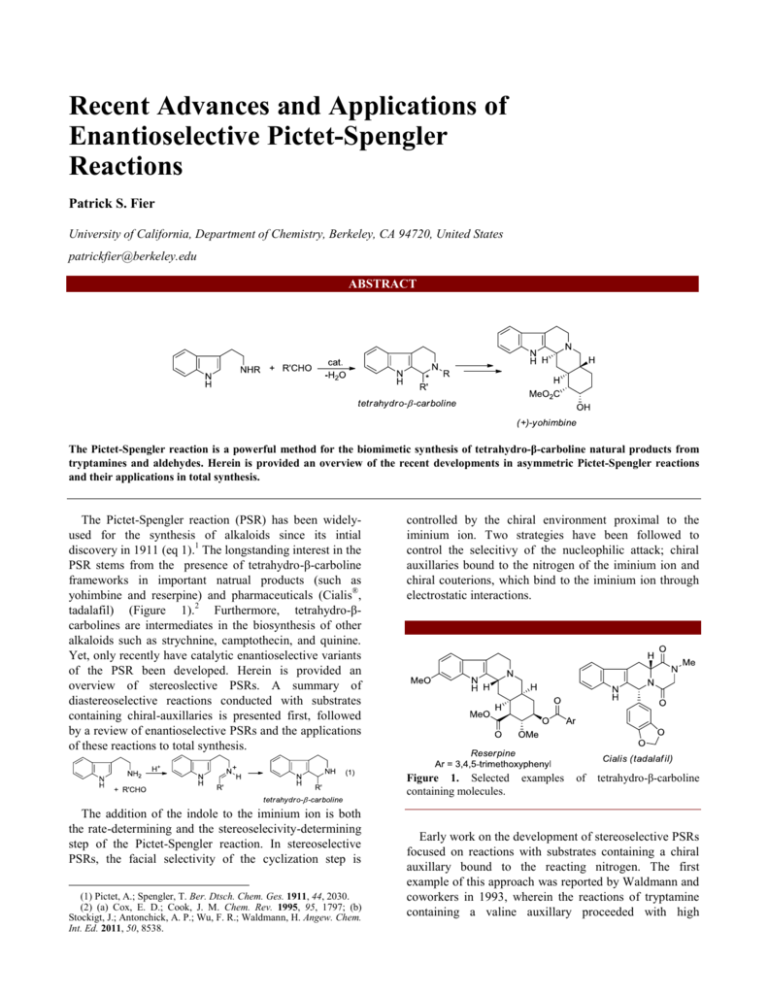
Recent Advances and Applications of Enantioselective Pictet-Spengler Reactions Patrick S. Fier University of California, Department of Chemistry, Berkeley, CA 94720, United States patrickfier@berkeley.edu ABSTRACT The Pictet-Spengler reaction is a powerful method for the biomimetic synthesis of tetrahydro-β-carboline natural products from tryptamines and aldehydes. Herein is provided an overview of the recent developments in asymmetric Pictet-Spengler reactions and their applications in total synthesis. The Pictet-Spengler reaction (PSR) has been widelyused for the synthesis of alkaloids since its intial discovery in 1911 (eq 1).1 The longstanding interest in the PSR stems from the presence of tetrahydro-β-carboline frameworks in important natrual products (such as yohimbine and reserpine) and pharmaceuticals (Cialis®, tadalafil) (Figure 1).2 Furthermore, tetrahydro-βcarbolines are intermediates in the biosynthesis of other alkaloids such as strychnine, camptothecin, and quinine. Yet, only recently have catalytic enantioselective variants of the PSR been developed. Herein is provided an overview of stereoslective PSRs. A summary of diastereoselective reactions conducted with substrates containing chiral-auxillaries is presented first, followed by a review of enantioselective PSRs and the applications of these reactions to total synthesis. controlled by the chiral environment proximal to the iminium ion. Two strategies have been followed to control the selecitivy of the nucleophilic attack; chiral auxillaries bound to the nitrogen of the iminium ion and chiral couterions, which bind to the iminium ion through electrostatic interactions. Figure 1. Selected containing molecules. The addition of the indole to the iminium ion is both the rate-determining and the stereoselecivity-determining step of the Pictet-Spengler reaction. In stereoselective PSRs, the facial selectivity of the cyclization step is (1) Pictet, A.; Spengler, T. Ber. Dtsch. Chem. Ges. 1911, 44, 2030. (2) (a) Cox, E. D.; Cook, J. M. Chem. Rev. 1995, 95, 1797; (b) Stockigt, J.; Antonchick, A. P.; Wu, F. R.; Waldmann, H. Angew. Chem. Int. Ed. 2011, 50, 8538. examples of tetrahydro-β-carboline Early work on the development of stereoselective PSRs focused on reactions with substrates containing a chiral auxillary bound to the reacting nitrogen. The first example of this approach was reported by Waldmann and coworkers in 1993, wherein the reactions of tryptamine containing a valine auxillary proceeded with high diastereoslectivity (Scheme 1).3 However, multiple steps and harsh reaction conditions were required to remove the valine unit. The same group later reported reactions of tryptamine containing a chiral amide auxillary that reacted with equally high diasteroselectivity.4 The groups of Cook5 and Nakagawa6 showed that a phenethyl auxillary led to modest control of diastereoselectivity in the PSR, and the auxillary could be removed through hydrogenolysis after the reaction. More recently, Nsulfinyl tryptamines have been employed by Koomen and coworkers in diastereoselective PSRs.7 Although the reactions with this auxillary formed products in modest dr, the diatereomeric purity of the N-sulfinyl tetrahydroβ-carbolines were improved to >99:1 after a single recrystallization, allowing access to highly enantioenriched tetrahydro-β-carbolines after acidic cleavage of the N-S bond (HCl, EtOH, 5 min). Scheme 1. Chiral-auxillary controlled PSRs. Although reactions with chiral auxillaries allow for the synthesis of enantioenriched tetrahydro-β-carbolines, stereoselective reactions that do not require the installation and removal of a chiral auxillary can be of greater synthetic value. The first stereoselective PSR without a covalently bound chiral auxillary was disclosed by Nakagawa and coworkers in 1996 (Scheme 2).8 It was shown that the PSR between hydroxylamines and aldehydes in the presence of a stoichiometric amount of a chiral boron Lewis acid formed products in up to 90% ee.9 Hydroxylamines condense with aldehydes to form highly reactive nitrone electrophiles, allowing the reactions to be run at low temperature and proceed with good enantioselectivity. The same group later reported a binol-derived Brønsted acid for the same transformation (3) (a) Waldmann, H.; Schmidt, G.; Jansen, M.; Geb, J. Tet. Lett. 1993, 34, 5867; (b) Waldmann, H.; Schmidt, G.; Jansen, M.; Geb, J. Tetrahedron 1994, 50, 11865. (4) Waldmann, H.; Schmidt, G.; Henke, H.; Burkard, M. Angew. Chem. Int. Ed. 1995, 34, 2402. (5) Reddy, M. S.; Cook, J. M. Tetrahedron Lett. 1994, 35, 5413. (6) (a) Soe, T.; Kawate, T.; Fukui, N.; Hino, T.; Nakagawa, M. Heterocycles 1996, 42, 347; (b) Soe, T.; Kawate, T.; Fukui, N.; Nakagawa, M. Tetrahedron Lett. 1995, 36, 1857. (7) Gremmen, C.; Willemse, B.; Wanner, M. J.; Koomen, G. J. Org. Lett. 2000, 2, 1955. (8) (a) Kawate, T.; Yamada, H.; Soe, T.; Nakagawa, M. Tetrahedron: Asymmetry 1996, 7, 1249; (b) Yamada, H.; Kawate, T.; Matsumizu, M.; Nishida, A.; Yamaguchi, K.; Nakagawa, M. J. Org. Chem. 1998, 63, 6348. (9) Ipc = isopinocamphenyl (Scheme 2).10 Although these reactions allowed for the enantioselective synthesis of tetrahydro-β-carbolines without chiral auxillaries, the synthetic utility was limited by the need for hydoxylamine substrates and stoichiometric amounts of chiral reagents. Scheme 2. PSRs with stoichiometric chiral acids. The first catalytic asymmetric PSR was developed with a thiourea catalyst for the cyclization of in-situ generated N-acyliminium ions. Strongly electrophilic Nacyliminium ion intermediates were chosen to promote the stereo-determining cyclization at low temperature under mild conditions. It was proposed that a chiral thiourea would promote stereoselective cyclization through hydrogen-bonding interactions with the acyliminium ion. With this proposal in mind, the first catalytic enantioselective PSR was reported in 2004 by the Jacobsen group. These reactions were catalyzed by a thiourea flanked by amino acid and 1,2-diamine derivatives (Scheme 3).11 The scope of the reactions that occurred in high yield and enantioselectivity encompassed a range of aliphatic aldehydes. Aromatic aldehydes did not react in the presence of this catalyst. Scheme 3. Thiourea-catalyzed enantioselective acyl-PSRs. The acyl-PSR reaction catalyzed by Jacobsen’s thiourea catalyst was later used by the same group as a key step in the total synthesis of (+)-yohimbine (Scheme 4).12 The reaction between tryptamine and silyl-protected hydroxypropanal under the previously developed conditions formed the alkyl-substituted product in 81% (10) Kawate, T.; Yamada, H.; Matsumizu, M.; Nishida, A.; Nakagawa, M. Synlett 1997, 761. (11) Taylor, M. S.; Jacobsen, E. N. J. Am. Chem. Soc. 2004, 126, 10558. (12) Mergott, D. J.; Zuend, S. J.; Jacobsen, E. N. Org. Lett. 2008, 10, 745. yield and 94% ee. This interemediate was further elaborated in 9 steps to complete the asymmetric synthesis of (+)-yohimbine in 14% overall yield. The Hiemstra group later used similar thiourea-catalyzed PSRs in the enantioselective syntheses of mitragynine, paynantheine, speciogynine and yohimbine (Scheme 4).13 Scheme 5. Enantioselective PSRs of hydroxylactams. Scheme 4. Asymmetric syntheses via thiourea-catalyzed PSRs. The Jacobsen group later showed that the scope of thiourea-catalyzed PSRs encompasses the reactions of hydroxylactams (Scheme 5).14 The hydroxylactam reactants were formed by reduction of the corresponding imide with NaBH4 (R’ = H) or by addition of organolithium reagents (R’ = alkyl, aryl). TMSCl was added as a stoichiometric Lewis acid in the PSRs to form acyliminium ion intermediates. When R’ in the hydroxylactam of Scheme 5 was an alkyl or aryl group, a fully substituted stereocenter was generated in the reaction in up to 98% ee. This was the first example for the enantioselective generation of a fully-subsituted stereocenter in a PSR. The hydroxylactam PSR was used in a short synthesis of (+)-harmicine in 62% overall yield and 97% ee from tryptamine and succinic anhydride. After the initial report by the Jacobsen group, List and coworkers showed that enantioselective PSRs could be performed with a chiral phosphoric acid catalyst (Scheme 6).15 The stereoselectivity of the reactions is influenced by the proximity and orientation of the chiral phosphate anion and the iminium cation after proton transfer. Initial (13) (a) Kerschgens, I. P.; Claveau, E.; Wanner, M. J.; Ingemann, S.; van Maarseveen, J. H.; Hiemstra, H. Chem. Commun. 2012, 48, 12243; (b) Herle, B.; Wanner, M. J.; van Maarseveen, J. H.; Hiemstra, H. J. Org. Chem. 2011, 76, 8907. (14) Raheem, I. T.; Thiara, P. S.; Peterson, E. A.; Jacobsen, E. N. J. Am. Chem. Soc. 2007, 129, 13404. (15) Seayad, J.; Seayad, A. M.; List, B. J. Am. Chem. Soc. 2006, 128, 1086. attempts to perform the PSR between unsubstituted tryptamines and alkyl aldehydes led to the exclusive formation of aldol condensation products. To prevent side-reactions and to facilitate cyclization, tryptamines containing geminal dicarboxylates were used. The reactions of alkyl and aryl aldehydes catalyzed by a binapthol-derived phosphoric acid containing bulky aryl groups occurred to give products in 62-96% ee. These reactions were the first examples of enantioselective PSRs to form N-H tetrahydro-β-carbolines, but the utility of these reactions is limited by the need for geminal disubstitution, high catalyst loadings (20 mol %), and long reaction times (3-6 days). Scheme 6. Chiral phosphoric acid catalyzed PSRs. Following the work by List and coworkers conducted with a chiral phosphoric acid catalyst, the Hiemstra group reported an enantioselective PSR of N-sulfenyl tryptamines (Scheme 7) catalyzed by a similar chiral phosphopric acid.16 Reactions catalyzed by a phosphoric acid containing bis(trifluoromethyl)phenyl groups on the binol backbone occurred rapidly and with high (16) Wanner, M. J.; van der Haas, R. N. S.; de Cuba, K. R.; van Maarseveen, J. H.; Hiemstra, H. Angew. Chem. Int. Ed. 2007, 46, 7485. enantioselectivity. These PSRs reactions of both aliphatic and aryl aldehydes proceeded in modest yields and enantioselectivities. However, these reactions are limited by the need to install and remove the sulfenyl auxillary. Scheme 8. Enantioselective PSR-type cyclization cascades. Scheme 7. Chiral phosphoric acid catalyzed PSRs of Nprotected tryptamines. The same group later developed enantioselective PSRs of N-benzyl tryptamines with chiral phosphoric acid E (Scheme 7).17 The authors suggest that a benzyl protecting group is useful for subsequent oxidation reactions to prepare pyrroloquinolones. The PSRs of Nbenzyl tryptamines encompassed a broader range of aldehydes than the reactions reported earlier with a sulfenyl auxillary. This reaction was used as a key step in the enantioselective synthesis of (-)-arboricine.18 A similar PSR catalyzed by SPINOL-phosphoric acids was later reported.19 Recently, the You group demonstrated that phosphoric acid catalyzed PSRs can be used in tandem with olefin metathesis and/or isomerization to prepare tetrahydro-β-carbolines from allyl amines.20 Two enantioselective, intramolecule PSR-type cascade reactions via intermediate acyliminium ions have been described by Dixon and coworkers. The first report described the reaction of tryptamine with enol lactones and phosphoric acid catalyst E to form N-acyl products in high yields and enantioselectivities.21 A subsequent report described the reactions of more readily available ketoacids in place of enol lactones with catalyst E or H8E.22 These reactions formed products containing a fullysubsituted stereocenter in up to 99% ee (Scheme 8). These reactions are useful in that tryptamines can be used to form the same products as the reactions of pre-formed hydroxylactams reported by Jacobsen (Scheme 5).14 (17) Sewgobind, N. V.; Wanner, M. J.; Ingemann, S.; de Gelder, R.; van Maarseveen, J. H.; Hiemstra, H. J. Org. Chem. 2008, 73, 6405. (18) Wanner, M. J.; Boots, R. N. A.; Eradus, B.; de Gelder, R.; van Maarseveen, J. H.; Hiemstra, H. Org. Lett. 2009, 11, 2579. (19) Huang, D.; Xu, F. X.; Lin, X. F.; Wang, Y. G. Chem. Eur. J. 2012, 18, 3148. (20) (a) Cai, Q.; Liang, X. W.; Wang, S. G.; Zhang, J. W.; Zhang, X.; You, S. L. Org. Lett. 2012, 14, 5022; (b) Cai, Q.; Liang, X. W.; Wang, S. G.; You, S. L. Org. Biomol. Chem. 2013, 11, 1602 (21) Muratore, M. E.; Holloway, C. A.; Pilling, A. W.; Storer, R. I.; Trevitt, G.; Dixon, D. J. J. Am. Chem. Soc. 2009, 131, 10796. (22) Holloway, C. A.; Muratore, M. E.; Storer, R. I.; Dixon, D. J. Org. Lett. 2010, 12, 4720. Finally, the Jacobsen group has developed an enantioselective PSR catalyzed by the combination of a Brønsted acid and a thiourea (Scheme 9).23 This reaction allows for the enantioselective synthesis of a broad range of unprotected tetrahydro-β-carbolines in good yields and enantioselectivities at room temperature. The modular synthesis of the catalyst allowed for a large number of thioureas to be prepared and screened for activity in the PSR. Catalyst F was shown to provide products in high enantiopurity at room temperature when combined with benzoic acid as a co-catalyst. In contrast to their earlier report on the acyl-PSR (Scheme 3) which could only be applied to alkyl aldehydes, this reaction occurred in high yield and enantioselectivity with both alkyl and aryl aldehydes. To date, this reaction has the greatest scope and synthetic utility of enantioselective PSRs. Scheme 9. Enantioselective PSRs with Brønsted acid and thiourea co-catalysts. The Pictet-Spengler reaction has continued to be a powerful reaction in alkaloid synthesis 100 years after its discovery. Like several reactions in organic chemistry, early worked focused on using chiral auxillaries to control stereoselectivity, while more recent work has focused on the design of chiral catalysts. The recent work in enantioselective PSRs has allowed for efficient syntheses of several tetrahydro-β-carboline natural products. However, the main limitations of the reported enantioselective PSRs are the need for high catalyst loadings, long reaction times and/or a removable auxillary. These limitations should be addressed by future work in this area. (23 Klausen, R. S.; Jacobsen, E. N. Org. Lett. 2009, 11, 887
